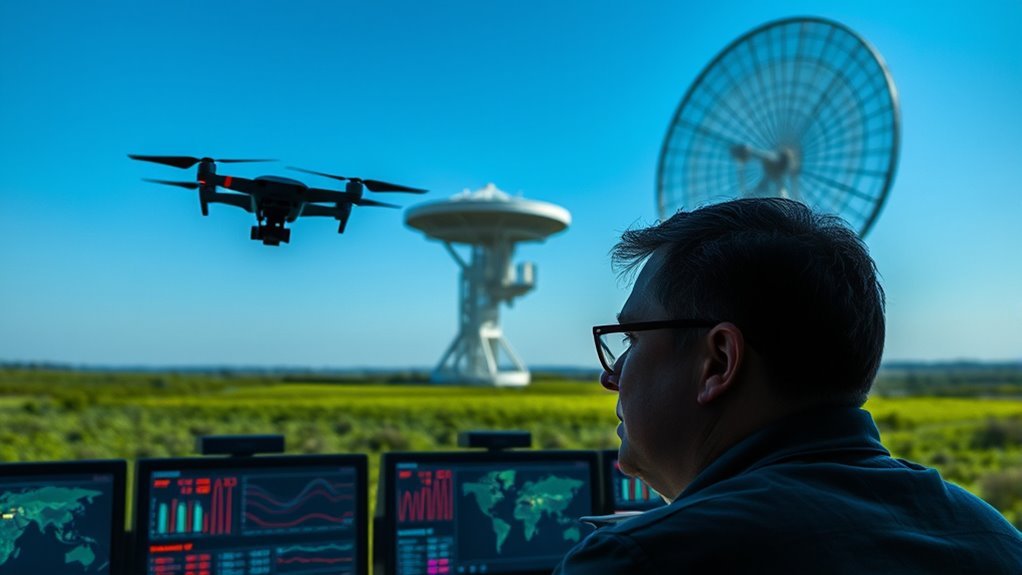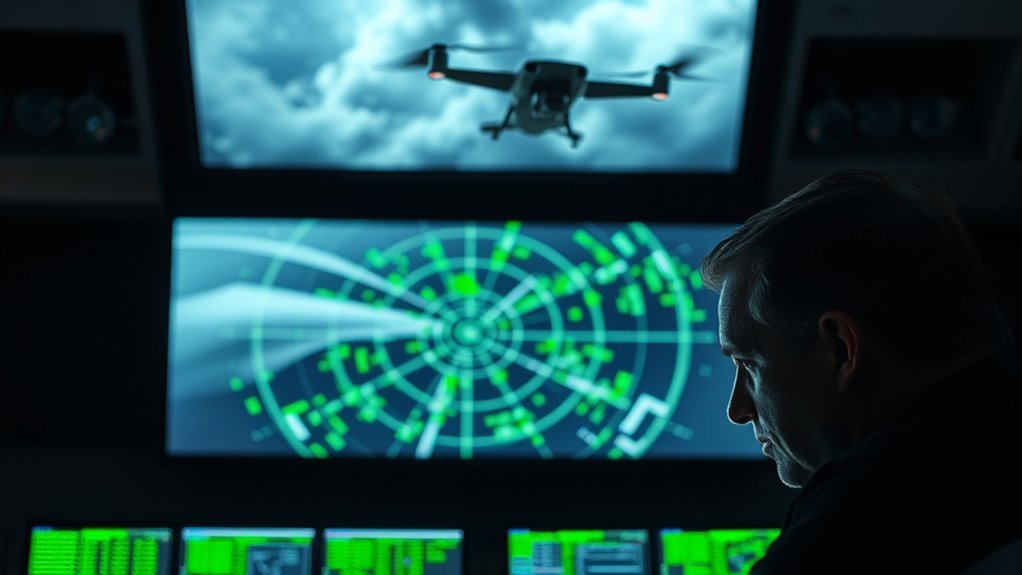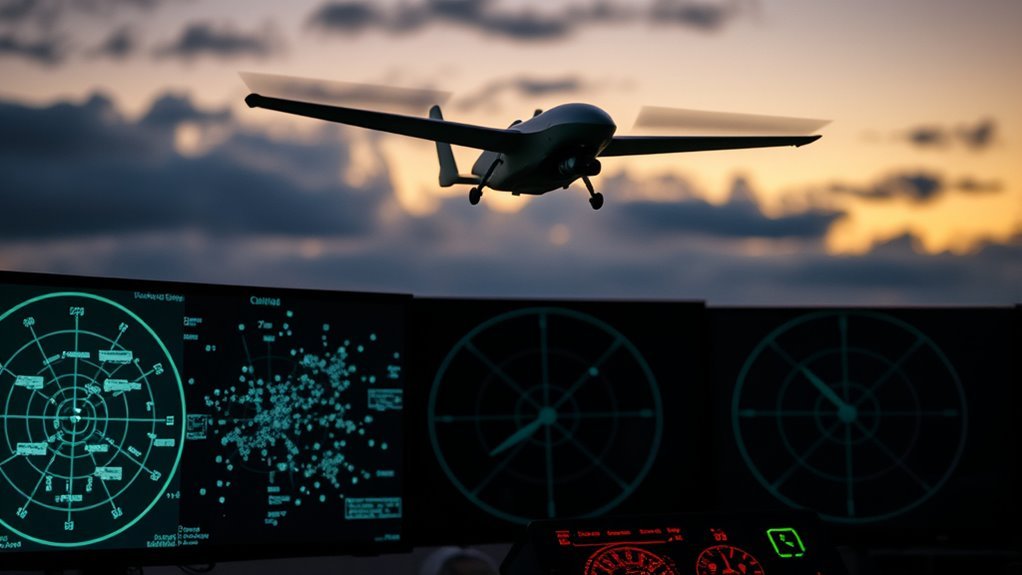You can determine if drones are detected by radar by analyzing the radar return signals for distinctive reflections that correspond to drone size, shape, and materials. Consider factors like the drone’s radar cross section (RCS), flight altitude, speed, and the radar type—pulse-Doppler or phased-array systems improve detection accuracy. Using secondary sensors such as infrared or acoustic devices helps validate radar data. Understanding these fundamentals reveals the nuances affecting reliable drone detection and verification.
Understanding Radar Technology Basics

Radar operates by emitting radio waves and analyzing the signals that bounce back after hitting objects. When you understand radar waveforms, you grasp how different pulse shapes and frequencies influence detection capabilities. The shape and timing of these waveforms determine the radar’s resolution and range, essential for identifying small or fast-moving targets like drones. Signal processing then refines the returned echoes, filtering noise and extracting meaningful data. You rely on advanced algorithms to interpret these signals accurately, maximizing detection while minimizing false alarms. Mastering these fundamentals gives you the freedom to evaluate radar effectiveness critically, especially when determining whether a drone can be detected. By focusing on waveform design and signal processing, you gain control over understanding radar’s limitations and strengths without unnecessary complexity.
How Radar Systems Detect Aerial Objects

When tracking aerial objects, you’ll rely on the radar system’s ability to emit pulses and listen for reflected signals that indicate presence and position. Radar signal propagation involves electromagnetic waves traveling through the atmosphere, reflecting off objects, and returning to the receiver. The strength and timing of these echoes allow you to calculate distance, speed, and trajectory. For effective aerial object classification, the radar analyzes parameters like signal return intensity, Doppler shifts, and radar cross-section variations. These factors help differentiate between birds, drones, or manned aircraft. By interpreting this data precisely, you maintain situational awareness and preserve your freedom to operate without interference. Understanding these detection mechanics empowers you to evaluate whether drones are identifiable amidst diverse aerial activities using radar technology.
Challenges of Detecting Small Drones With Radar

When you’re trying to detect small drones, their minimal radar cross section greatly reduces the reflected signal strength, making identification difficult. Additionally, signal interference from clutter and environmental noise can mask or distort these weak returns. Understanding these factors is essential for evaluating radar effectiveness against small aerial targets.
Radar Cross Section
Detecting small drones poses significant challenges due to their minimal radar cross section (RCS), which quantifies how much radar energy an object reflects back to the sensor. Because drones are constructed from lightweight materials and have compact frames, their radar signatures are inherently weak, making traditional detection techniques less effective. You’ll find that the RCS varies with drone orientation, size, and surface composition, complicating consistent identification. To overcome this, advanced radar systems employ enhanced signal processing and adaptive filtering to isolate these faint radar echoes from background noise. Understanding and accurately measuring a drone’s RCS is essential for refining detection techniques, enabling you to better anticipate radar performance limits and improve freedom in drone operation without compromising situational awareness.
Signal Interference Effects
Although radar systems are designed to identify objects by analyzing reflected signals, signal interference greatly complicates the detection of small drones. You’ll encounter signal distortion caused by environmental factors like terrain, weather, and man-made structures, which alter the radar return and mask the drone’s presence. Interference patterns emerge when multiple signals overlap, producing constructive and destructive interference that can obscure or mimic drone echoes. As a result, distinguishing genuine drone reflections from background noise demands advanced signal processing techniques and adaptive filtering. Understanding these interference effects is essential if you want reliable detection without sacrificing operational freedom. By mitigating signal distortion and analyzing interference patterns, you can enhance radar sensitivity and reduce false negatives, ensuring drones don’t exploit gaps in radar surveillance.
Radar Cross Section and Drone Visibility
Since the radar cross section (RCS) quantifies how much electromagnetic energy a drone reflects back to a radar system, understanding it is essential for evaluating drone visibility. The RCS depends heavily on drone size; larger drones typically exhibit a greater RCS, increasing their detection range. However, shape and orientation also influence the effective cross section, causing fluctuations in radar returns. When analyzing detection range, you must factor in the RCS as it directly impacts the minimum signal strength a radar receiver requires to identify the drone. Small drones with minimal RCS can evade detection by remaining below radar sensitivity thresholds, granting operational freedom. By accurately estimating RCS relative to drone size, you can analytically predict visibility and tailor drone deployment strategies to avoid or exploit radar detection capabilities.
Influence of Drone Materials on Radar Detection
You need to evaluate how different materials affect a drone’s radar reflectivity, especially composites versus metal components. Metals typically produce a stronger radar signature due to higher conductivity, while composites can reduce detectability by absorbing or scattering radar waves. Understanding these material properties is critical for evaluating a drone’s overall radar signature.
Radar Reflectivity of Composites
When evaluating a drone’s radar detectability, the materials used in its construction play a critical role in how radar waves reflect off its surface. Composite materials, commonly used in drone frames, offer distinct radar absorption properties compared to metals. These composites, often carbon fiber or fiberglass-based, exhibit lower radar reflectivity due to their dielectric characteristics, which reduce the energy reflected back to radar receivers. However, the exact radar absorption depends on the composite’s fiber orientation, resin type, and thickness. By selecting composites with optimized electromagnetic properties, you can effectively minimize radar signature, enhancing stealth. Understanding these nuances allows you to assess a drone’s radar footprint more accurately, granting you freedom to design or choose drones that evade detection by exploiting composite materials’ inherent radar absorption advantages.
Metal Components and Signature
Several factors influence how metal components affect a drone’s radar signature, primarily due to metals’ high electrical conductivity and reflectivity. When you analyze a drone’s metal composition, even small metallic parts can cause pronounced radar returns, increasing detectability. The shape, size, and placement of these components alter the radar cross-section, making some drones easier to detect than others. However, detection limitations arise when metal parts are minimized or combined with radar-absorbent materials, reducing radar reflectivity. You should also consider that certain alloys and metal treatments can modify electromagnetic responses, further complicating detection. Understanding these nuances allows you to better predict how a drone’s metal elements impact radar visibility, balancing design freedom with operational stealth requirements in radar environments.
Role of Flight Altitude and Speed in Radar Detection
Flight altitude and speed critically influence a drone’s radar signature and its likelihood of detection. Understanding altitude impact is key: lower altitudes often increase ground clutter, complicating detection, but can also reduce line-of-sight to radar, affecting signal strength. Speed relevance is equally important; faster drones create more distinct Doppler shifts, making them easier to detect, while slower speeds may blend into background noise.
Consider these factors to assess radar detection probability:
- Altitude impact: Higher altitudes improve radar line-of-sight but reduce signal reflection intensity.
- Speed relevance: Increased velocity enhances Doppler return, aiding detection algorithms.
- Flight behavior: Erratic maneuvers alter radar returns, potentially increasing detectability.
Types of Radar Systems Used for Drone Detection
Radar systems play an essential role in detecting drones by emitting radio waves and analyzing the reflected signals to identify objects in the airspace. When exploring radar types for drone detection, you’ll encounter both pulse-Doppler and continuous-wave radars, each employing distinct detection methods. Pulse-Doppler radar excels at measuring velocity and range, effectively filtering out clutter to detect slow-moving drones. Continuous-wave radar, meanwhile, provides precise velocity measurements but lacks range data. Additionally, phased-array radars offer rapid beam steering, improving tracking of agile drones. Understanding these radar types and their detection methods is vital, especially if you value operational freedom and need reliable drone awareness. Selecting the appropriate radar system depends on factors like drone size, speed, and flight patterns, ensuring accurate detection without compromising your airspace liberties.
Using Secondary Sensors to Enhance Drone Detection
You can improve drone detection accuracy by integrating secondary sensors like infrared cameras, which identify heat signatures undetectable by radar. Acoustic detection methods pick up drone-specific sound patterns, adding another layer of identification. Additionally, monitoring radio frequency emissions helps track drone control signals, enhancing overall situational awareness.
Infrared Sensor Integration
Although radar systems provide primary detection capabilities, integrating infrared sensors greatly enhances your ability to identify drones, especially those with low radar cross-sections or stealth features. Infrared sensor integration allows you to detect thermal signatures emitted by drone motors and batteries, even under low visibility. This secondary sensor complements radar by providing:
- Enhanced target discrimination through heat signature analysis
- Improved detection in cluttered or visually obscured environments
- Real-time tracking when radar returns are weak or ambiguous
Acoustic Detection Methods
Acoustic detection methods leverage the unique sound signatures produced by drone propellers and motors to identify their presence, supplementing radar and infrared systems. By employing sound wave detection, you can discern drone-generated acoustic patterns amid environmental noise. This approach enhances detection accuracy, particularly in cluttered or low-visibility conditions.
| Parameter | Benefit | Challenge |
|---|---|---|
| Frequency Range | Targets drone-specific tones | Overlaps with ambient sounds |
| Sensor Sensitivity | Detects low-decibel signals | False positives from wildlife |
| Signal Processing | Filters environmental noise | Requires computational power |
Integrating acoustic data with other sensor inputs empowers you to maintain operational freedom while reliably identifying drones, even in complex acoustic environments.
Radio Frequency Monitoring
Complementing sound-based detection, radio frequency (RF) monitoring captures the electromagnetic signals drones emit during communication and control operations. By analyzing these signals, you gain insight into specific frequency patterns unique to drone activity, enhancing detection accuracy beyond radar capabilities alone. RF monitoring leverages advanced signal analysis to distinguish drones from other RF sources, maintaining your operational freedom without intrusive measures.
Key advantages of RF monitoring include:
- Identification of drone control signals through signature frequency patterns
- Real-time signal analysis to detect unauthorized drone presence
- Integration with radar data to improve detection reliability and reduce false alarms
This secondary sensor approach empowers you to maintain situational awareness while respecting airspace freedoms, ensuring drones are detected effectively without unnecessary restrictions.
Practical Methods to Verify if a Drone Is Detected
When you’re trying to confirm whether a drone is being detected by radar, relying solely on radar readouts can be insufficient due to potential signal interference or false positives. To verify detection practically, integrate multiple drone detection methodologies such as visual confirmation, infrared imaging, and acoustic sensors alongside radar data. Cross-referencing these inputs reduces ambiguity and strengthens verification accuracy. Employing radar technology advancements like Doppler processing and adaptive filtering enhances signal clarity but still benefits from corroborative methods. You should also consider situational factors—weather conditions and terrain can affect radar returns. By systematically combining these verification techniques, you maintain operational freedom while ensuring reliable detection. This approach mitigates reliance on any single system, allowing you to confidently determine whether a drone is truly detected within your monitored airspace.
Emerging Technologies Improving Drone Radar Detection
Building on the need to combine multiple verification methods, advancements in radar technology are rapidly enhancing the detection of increasingly smaller and stealthier drones. You’ll find emerging technologies are vital in overcoming traditional radar limitations by improving sensitivity and resolution through:
- Phased array radar systems that dynamically steer beams for rapid target acquisition without mechanical movement.
- Machine learning algorithms that analyze radar signatures to distinguish drones from birds or other clutter.
- Frequency-modulated continuous-wave (FMCW) radar offering superior range and velocity detection capabilities for low-RCS targets.
These radar advancements empower you to maintain airspace freedom by accurately identifying unauthorized drones while minimizing false positives. Embracing these technologies guarantees your detection systems evolve alongside drone innovation, preserving your ability to monitor and control drone activity effectively.

